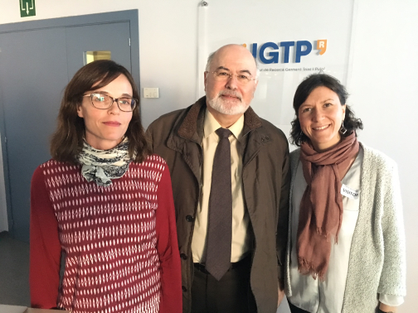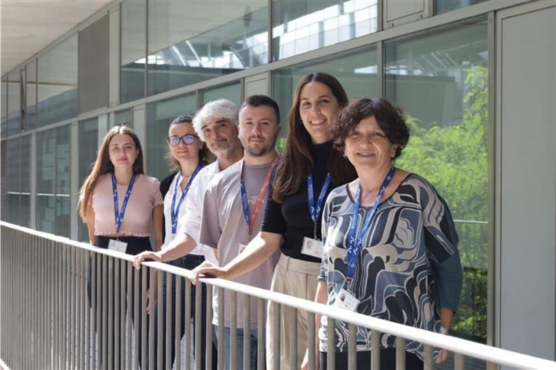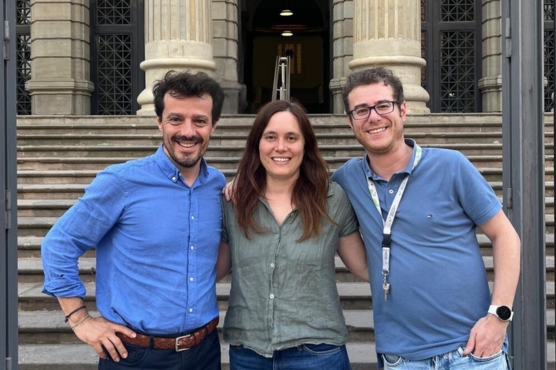“A great effort must therefore continue to be made to identify new biomarkers, as well as more specific therapeutic targets, in order to reduce the level of toxicity of treatments.”
In March, at the Josep Carreras Leukaemia Research Institute’s ICO – Germans Trias i Pujol campus, we had the great pleasure of receiving a visit by Dr. José Fernández Piqueras, who has been Chair of Genetics at the Autonomous University Madrid (UAM) since 1986. He combines his teaching work with research as a group leader at the Severo Ochoa Centre for Molecular Biology (CBMSO, UAM/Spanish National Research Council – CSIC). At the present time he forms part of the Rare Diseases Biomedical Research Centre (CIBERER) and the Jiménez Díaz Foundation’s Health Research Institute (IIS-FJD), both of which are affiliated to the Carlos III Health Institute (ISCIII).
Dr. Fernández Piqueras gave a talk entitled, “Epigenetic and genetic alterations in T-cell lymphoblastic lymphoma”.
In his free time Dr. Fernández Piqueras likes reading, walking and enjoying the wonder of open spaces, but above all he is devoted to his family, his wonderful wife, his three adorable grown-up children and his grandchildren.
We wanted to talk to Dr. Fernández Piqueras about the challenges he faces in his work.
● Dr. Fernández, in your talk you focused on T-cell lymphoblastic lymphoma, an aggressive kind of non-Hodgkin lymphoma that mainly affects children. What are the main characteristics that define this kind of lymphoma and how prevalent is it in our country?
T-cell lymphoblastic neoplasias are considered by the World Health Organisation to be hematological diseases comprising two subgroups: lymphoblastic lymphomas and acute lymphoblastic leukaemias. In both cases they have their origin in the malignancy of immature thymocytes at different stages during their intrathymic differentiation. Although some differences between these subgroups have been described, mainly quantitative differences and others concerning responses to chemotherapy and angiogenesis, the clinical importance of these differences has yet to be demonstrated.
From the clinical point of view, patients present an excessively high number of white blood cells in their blood together with hematopoietic disorders such as neutropenia, anemia and thrombocytopenia. They tend to present infiltration of the central nervous system. Most patients are diagnosed as suffering from acute leukaemias, but those who present a mediastinal mass and a limited degree of bone marrow infiltration (less than 25%) are included in the lymphoblastic lymphoma subgroup.
In Europe the incidence of this kind of neoplasia is 1.28/100,000 cases per year, which makes this kind of cancer a rare disease (≤5/10,000 cases per year). That is why our group became affiliated to the Rare Diseases Biomedical Research Centre (CIBERER) consortium, established by the Carlos III Health Institute (ISCIII), so that research into this kind of disease would not be neglected. Be that as it may, the incidence of the disease, its physiopathology, and response to treatment depend, to a large extent, on whether the patient is a child or an adult.
● What genetic and epigenetic alterations have been discovered in the course of studies into this lymphoma subtype?
Most of the genetic and epigenetic alterations are shared with acute T-cell lymphoblastic leukaemias. The most frequent genetic and epigenetic alterations include:
-Chromosome reordering that attracts known oncogenes to the control regions of TCR genes;
-Chromosome deletions, such as 9p (which affects the p16 suppressor gene p16) and the 6q;
-Activating mutations on key oncogenes (such as NOTCH1 and JAK1);
-Mutations in epigenetic modifiers that affect DNA methylation patterns and the chromatin structure found in tumour samples.
Amongst our contributions I would like to highlight:
-The identification of alterations with prognosis value in genes expressed exclusively by stromatic cells accompanying the lymphoma;
-The identification of a new suppressor gene in 6q deletion;
-The alterations of different members of the FAS-FASL apoptosis pathway, with a proposed model to estimate the level of aggression of lymphomas;
-The demonstration of a considerable degree of intratumoural heterogeneity exemplified by a member of the Janus (JAK2) kinase family where, furthermore, some mutations appear exclusively in the genetic transcription without it having been possible to find them previously in the genome.
● In your talk you mentioned the study of MicroRNAs. Could you tell us what MicroRNAs are and what information their study might produce?
One of the greatest challenges in biology, and especially in genetics, has been, and continues to be, to unravel the complex tangle of mechanisms which control gene expression that makes it possible for cells to live, differentiate or become malignant. The interference mechanisms mediated by small molecules of double stranded RNA, such as those involving microRNAs, are the most recent example.
Andrew Fire and Craig Mello were awarded the Nobel Prize for Physiology or Medicine in 2006 for their discovery. MicroRNAs are small molecules of double stranded, non-coding RNA (that is to say, they do not translate into proteins), which are used as guides by ribonucleoprotein complexes to locate messenger RNAs produced by coding genes, facilitating their degradation or inhibiting their translation into proteins. They are therefore expression modulators.
Their effect could be likened to fine tuning a radio, without which it would not be possible to hear the music clearly. The first evidence of their implication in cancer was obtained in 2002 (in chronic lymphocytic leukaemia), and in 2007 the first evidence was obtained of their implication in T-cell lymphoblastic neoplasias.
Since then they have become essential and enormously useful for establishing clinical cancer subgroups and the design of new therapeutic strategies. Our contribution in this field has been the identification of new deregulated microRNAs in T-cell lymphoblastic lymphomas that are capable of controlling oncogenes such as ABL1 (or the BCR-ABL fusion gene), c-MYC, SMO, FBXW7, etc.
● In comparison with other lines of study, what is different about studies into MicroRNAs, and what potential do they have?
They represent a new and promising focus for cancer research. It should not be forgotten that miRNAs are capable of controlling the expression of more than 60% of protein-coding genes, that many of them appear deregulated during the various phases of tumour development, and that they produce genetic fingerprints that are extremely useful in diagnosis, prognosis and even for predicting therapeutic responses. Furthermore, new therapeutic trials are being developed based on the use of more stable synthetic derivatives within the framework of a new conception of genetic therapy in cancer.
● What are the next challenges for research into this lymphoma subtype?
Although current treatment protocols based on polychemotherapy are producing good results, especially in childhood cancers, resistance to treatment and relapse continue to pose very great problems. A great effort must therefore continue to be made to identify new biomarkers, as well as more specific therapeutic targets, in order to reduce the level of toxicity of treatments. To a large extent, coming challenges will need to encompass the integration of data derived from the application of new strategies for latest-generation genome analysis (Whole Exome, RNA-Seq, Targeted Seq) during the evolution of the lymphoma, from its diagnosis to possible relapse, in the context of a new, personalised precision medicine.
More attention will also need to be paid to epigenetic and epigenomic questions, and the genetic messages that tumour cells send through body fluids and, particularly, those transferred by exosomes. The results obtained will culminate with the corresponding preclinical trials based on xenotransplanted animal models using the patient’s tumour cells, and the use of new, more effective and less toxic, therapeutic agents.
● The Josep Carreras Foundation has established a research centre specifically for leukaemia and other malignant blood diseases, the IJC. What do you think the repercussions of this will be, both for medical science and for society at large?
Simply vital. Blood diseases have their own characteristics and bringing them together at this centre makes it possible to optimise the technical and methodological resources and infrastructure. This means that research work is much more effective and more readily translated to clinical practice, and with considerable savings, and the more efficient use of public and private funding.
The presence of a person of such renown as Josep Carreras as its president definitely lends the Foundation the national and international reputation and influence it needs. He is, without doubt, the cornerstone of the entire project and its main guarantee for success.
Thank you very much!








